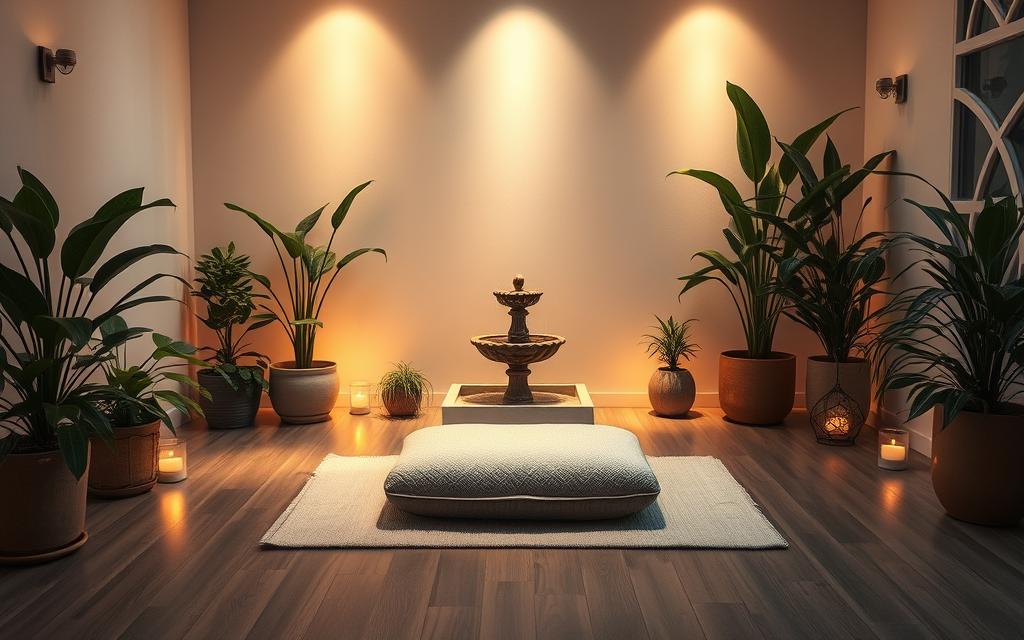Ever wondered how to tap into your subconscious mind? The answer might be self-hypnosis relaxation. It’s a powerful tool that can change your life. Let’s explore how it can help you grow and discover yourself.
Self-hypnosis lets you focus deeply and control your thoughts and feelings. It takes you into a state of deep relaxation. This way, you can unlock your subconscious mind’s power.
It can boost your creativity, teach you new skills, and help you manage stress. Self-hypnosis can also help you face your fears. The benefits are amazing.
Are you ready to unlock self-hypnosis’s secrets? Let’s start this journey together. Discover how self-hypnosis can help you achieve your dreams and live a better life.
Understanding the Power of Self-Hypnosis
Self-hypnosis lets people enter a state of deep focus and openness to suggestions. It’s different from hypnotherapy, which is done with a professional’s help. Both aim to reach the subconscious mind to change thoughts and behaviors for the better.
Defining the Everyday Trance State
The trance state of self-hypnosis is not rare or magical. It’s a normal state we enter when we’re fully focused on something. It’s like being completely absorbed in a great book or movie.
The Science Behind Mental Focus
When we’re fully focused, our critical thinking takes a backseat. This lets our subconscious mind soak up positive ideas and images. Mindfulness techniques and hypnotherapy help us get into this state. They let us tap into our subconscious for personal growth.
How Self-Hypnosis Differs from Traditional Hypnosis
The main difference is who guides you. Hypnotherapy is done with a professional, while self-hypnosis is done by yourself. Being able to do it yourself can be powerful. But, it takes practice and dedication to see results.
The History and Evolution of Hypnotic Practices
Hypnosis has a long and interesting history. Franz Anton Mesmer is seen as the start of modern hypnosis. He believed in “cosmic energy” that could move between people. Though his views are outdated, they still shape how we see hypnosis today.
In the 1800s, Josef Breuer used hypnosis to help Anna O with her hysteria. This showed hypnosis’s healing power. Later, the American Psychological Association’s Division 30 Society of Psychological Hypnosis was formed. This made hypnosis more accepted in medicine.
Hypnosis has changed over time. Milton Erickson was a key figure who used hypnosis to help people. His method, Ericksonian hypnosis, is still used today. It’s linked to modern techniques like neuro-linguistic programming (NLP).
Other important names in hypnosis history include James Braid and Emile Coué. Braid came up with the terms “hypnotism” and “hypnosis.” Coué used autosuggestion to help people heal themselves.
Now, hypnosis is used in regular medicine to help with many issues. This includes stress, high blood pressure, migraines, sleep disorders, and addictions. It’s taught in schools around the world. It’s becoming a popular way to reduce stress and anxiety.

The journey of hypnotic practices is truly captivating. It shows how powerful our minds are and how they can heal. As we learn more, hypnosis will likely help even more people with stress and anxiety.
Self-Hypnosis Relaxation: Core Principles and Methods
Self-hypnosis lets us reach our subconscious mind. This is where our thoughts, feelings, and actions are stored. By accessing this area, we can change our mindset for the better and find mental calmness.
The Role of Conscious and Subconscious Mind
Our conscious mind is just the surface, but the subconscious is much bigger. Self-hypnosis helps us connect these two parts. It lets us use our subconscious for good changes.
Deep breathing and visualization help us get into a special state. This state makes us more open to change.
Building Mental Framework for Success
- Be open and ready to learn. Self-hypnosis needs you to be open and willing.
- Make positive statements that match what you want. These deep breathing exercises will be the base of your success.
- Practice regularly. Being consistent is crucial for changing your subconscious mind and getting lasting results.
Self-hypnosis is a strong tool for personal growth. It helps you use your conscious and subconscious minds together. This way, you can reach new levels of mental calmness, focus, and self-control.
Creating the Perfect Environment for Practice
Getting your environment right is key for a good self-hypnosis session. Find a quiet, private place away from tech and people. Wear comfy clothes that let you relax and concentrate. Tell others nearby to keep quiet while you practice.
Your space should feel calm and focused, like a sleep or meditation area. Theta brainwaves, linked to daydreaming and trance, can be triggered by binaural beats. This makes your mind calm and deepens your self-hypnosis.
- Clear out clutter and distractions for a peaceful vibe.
- Use soft, calming lights like candles or daylight to set the mood.
- Add soothing scents, like essential oils, to relax your senses further.
The right physical setting is important for getting into a hypnotic state. A clean, organized space makes you feel more relaxed and open. Pick wall colors that are calming to help your mindset.
In the pre-talk phase, use conversational hypnosis to connect and prepare for your session. With the perfect environment, you’ll focus better and achieve mental clarity for self-improvement.

Essential Steps to Enter a Hypnotic State
Getting into a hypnotic state can help you relax deeply, reduce stress, and change for the better. By following a few easy steps, you can unlock the power of self-hypnosis. This can bring you greater mental clarity and focus. Let’s look at the key techniques to guide you into a hypnotic trance.
Breathing Techniques for Deep Relaxation
Proper breathing is key to entering a hypnotic state. Start by looking at a single point at eye level. Breathe slowly and deeply through your nose, letting your belly rise and fall. As you exhale, feel the tension leave your body.
This deep breathing helps calm you down and focus your mind. It prepares you for successful self-hypnosis.
Progressive Muscle Relaxation Methods
After you’ve found a rhythm with deep breathing, it’s time to relax your body. Close your eyes slowly, letting them feel heavier. Imagine a peaceful place, like a calm beach or a lush forest.
Picture the heaviness spreading from your head to your toes. Focus on tensing and then releasing each muscle group. This creates a deep sense of relaxation.
By combining deep breathing and muscle relaxation, you can enter a hypnotic state. This lets you tap into your subconscious mind. Regular practice can improve your mindfulness, reduce stress, and boost your overall well-being.
Mastering Visualization Techniques
Visualization is a strong tool in guided meditation and self-hypnosis. It helps people find deeper mental calmness and focus. Start by relaxing, then imagine a happy, peaceful scene. Focus on every detail of your visualization.
To improve your visualization, pick a scene that shows your goal. This could be falling asleep easily or staying calm under stress. Use positive affirmations to support your goal. Just 5 minutes a day can greatly improve your well-being.
- Begin by setting up a calm, relaxing space for your practice.
- Use your senses to imagine the scene you want, including sights, sounds, smells, and feelings.
- Repeat your goal or intention while keeping your focus on the mental image.
- Being consistent is crucial. Make visualization a daily part of your routine to see the best results.
Mastering visualization takes practice and commitment. By adding it to your self-care, you can feel more calm and reach your goals more easily.

The Connection Between Self-Hypnosis and Meditation
Self-hypnosis and meditation both focus on quieting the mind and finding inner peace. Scientists see the hypnotic state as a form of meditation. Yet, they also have their own unique qualities.
Key Differences and Similarities
Self-hypnosis and meditation both aim to relax and focus the mind. But they use different methods and goals. Hypnosis uses imagination and suggestibility to change beliefs. Meditation, by contrast, focuses on being present without a goal.
Studies show both practices activate similar brain areas. These areas are linked to attention, emotions, and decision-making. Both also lead to a calm state by balancing the body’s nervous system.
Combining Both Practices for Enhanced Results
Many people mix self-hypnosis and meditation for better mental health and goal setting. Self-hypnosis helps those who find it hard to stay focused in meditation. Meditation, in turn, can make self-hypnosis more effective.
By blending mindfulness techniques and mental calmness practices, you can leverage the best of both worlds. This approach can lead to deeper personal growth and change.
Therapeutic Applications and Benefits
Self-hypnosis is becoming more recognized as a powerful tool for therapy. It has scientific backing for managing health issues like pain, anxiety, and improving sleep and mood.
Research shows it’s great for stress relief and anxiety reduction. It helps in palliative care to lessen pain and anxiety during treatments. It also helps improve sleep, which is good for those going through menopause.
Self-hypnosis has shown benefits for many health issues, including sickle cell disease. A review found it can make cognitive-behavioral therapy more effective for phobias, obesity, and anxiety.
It also helps with emotional and mental health. Studies have shown it’s effective in managing anxiety, pain, nausea, and vomiting in cancer patients.
While it may take time to see results, the benefits are worth it. Self-hypnosis can improve focus, creativity, reduce stress, boost self-esteem, and help with pain. With practice, it can greatly enhance well-being.

Remember, self-hypnosis is generally safe but always check with a healthcare professional, mainly if you have health issues. Using self-hypnosis as part of a wellness plan can unlock the mind’s power for stress relief and anxiety reduction.
Self-Hypnosis for Stress Management
In today’s fast world, stress and anxiety are common. But, you have a powerful tool to manage these feelings – self-hypnosis. It uses your subconscious mind to find quick relief and reduce stress over time.
Techniques for Immediate Stress Relief
When stress hits, act fast. Start with your breathing. Take slow, deep breaths, letting your belly rise and fall. Imagine calm scenes, like a peaceful beach or forest, as you breathe in.
Visualization is another great tool. Imagine a safe, cozy spot, like a cabin or a meadow. Use all your senses to feel the scene. Let go of tension and anxiety as you dive into this mental escape.
Long-term Stress Reduction Strategies
Quick fixes are helpful, but daily self-hypnosis is crucial for lasting stress management. Spend a few minutes each day on self-hypnosis. Use positive affirmations and imagine yourself handling stress well. This practice can change your brain, helping you stay calm.
Combine self-hypnosis with other relaxation methods, like meditation or exercise. This creates a strong stress-reduction plan. Take back your well-being and live a more balanced life with self-hypnosis.
Overcoming Sleep Disorders Through Self-Hypnosis
Struggling with sleep issues? Guided meditation and mental calmness through self-hypnosis can help. This method has shown great promise in improving sleep, even for those with sleep disorders or menopause-related sleep issues.
Self-hypnosis lets you relax deeply, quieting your conscious mind. This allows your subconscious to soak up positive thoughts and images. By picturing peaceful sleep scenarios, using progressive muscle relaxation, and creating sleep-positive affirmations, you can train your mind and body for better sleep.
Studies have backed the benefits of self-hypnosis for sleep. A review of 24 papers found 58.3% of participants saw better sleep quality with hypnotherapy. Another study showed shift workers got better sleep, less daytime fatigue, and fell asleep faster with hypnosis.
Regular use of self-hypnosis can lead to lasting sleep improvements. It can help with insomnia, sleep apnea, and other sleep disorders. Let guided meditation and mental calmness through self-hypnosis help you get the restful nights you need.

Breaking Unwanted Habits with Hypnotic Suggestions
Getting rid of unwanted habits can be tough, but hypnotherapy makes it possible. It works by reaching your subconscious mind, where habits live. With the right trance state, you can use affirmations and techniques to beat any habit.
Crafting Effective Affirmations
Good affirmations are positive, in the present tense, and clear. Say “I am a non-smoker” instead of “I will quit smoking.” This makes your subconscious accept the change. Say these affirmations often, during hypnotherapy and every day, to keep the change real.
Reinforcement Techniques
- Visualization: Picture yourself winning over the habit, feeling good, and strong. This mental picture helps make new brain paths.
- Journaling: Write down your journey, wins, and struggles. It gives you insight and keeps you motivated.
- Accountability: Get support from loved ones or a hypnotherapist. They help you stay focused and celebrate your wins.
Using hypnotherapy with these methods can help you overcome habits. It’s a step towards self-empowerment and growth.
Enhancing Personal Growth and Self-Confidence
Self-hypnosis is a strong tool for boosting self-esteem and confidence. It lets people see themselves succeeding in tough spots, like speaking in public or having tough talks. By making personal affirmations, it helps build a positive self-image and boosts self-worth.
Studies show self-confidence can grow with practice. Hypnosis makes new paths in the mind, replacing doubts with confidence. Regular use can improve how you see yourself and help you reach your goals.
Hypnotherapy has changed lives, leading to job promotions, following dreams, and forming strong bonds. When picking a hypnotherapist, look at their credentials, experience, and what others say to find a good one.
Getting ready for self-hypnosis means setting goals, picking a cozy spot, and being open-minded. Mixing self-hypnosis with mindfulness techniques can make you even more calm and aware. This opens the door to lasting growth and confidence.
Common Challenges and How to Overcome Them
Starting a guided meditation or stress relief journey with self-hypnosis can change your life. But, it comes with its own set of challenges. Knowing these obstacles and how to beat them is key.
One big challenge is staying focused during sessions. It’s easy to get sidetracked by things outside or your own thoughts. Start with short sessions and slowly make them longer. If your mind wanders, just gently bring it back to your chosen focus.
Another problem is feeling bored. As you keep practicing, the same scenes might start to feel the same. Try new images and stories to keep your mind excited. This can make your practice more interesting and keep you engaged.
Some people also worry about falling asleep. While it’s okay to relax, you want to stay awake for the benefits. Practice at times when you’re more alert. Adding energizing parts, like positive sayings or mental games, can help you stay awake and focused.
Remember, getting better at self-hypnosis takes time. Be kind to yourself and don’t get down if you hit a bump. By facing and solving these common problems, you’ll get better at self-hypnosis. This will help you with stress relief and personal growth.
Measuring Progress and Tracking Results
Starting a self-hypnosis journey is thrilling. It’s a step towards mental calmness and tapping into your subconscious. To see real results, set clear goals and keep a practice journal.
Setting Realistic Goals
Start by setting goals that are specific, measurable, and achievable. You might aim for how often you practice, how long each session is, or what you want to improve, like stress or habits.
Remember, progress might not come right away. But tracking your journey lets you celebrate small wins and adjust as you go. Regular practice is crucial for self-hypnosis benefits.
Maintaining a Practice Journal
- Record the date, time, and duration of each self-hypnosis session.
- Note the specific techniques or affirmations you used during the practice.
- Observe any changes in your mood, thoughts, or overall well-being.
- Reflect on any insights or breakthroughs you experienced.
- Identify any challenges or roadblocks you encountered and brainstorm solutions.
Looking over your practice journal often can show you patterns and progress. It helps you refine your self-hypnosis routine. By staying committed and celebrating your wins, you’ll understand how these mindfulness techniques can improve your mental calmness and well-being.
Safety Guidelines and Best Practices
Self-hypnosis is usually safe, but it’s key to follow some rules for a good experience. When you’re in a trance state induction or doing hypnotherapy, don’t drive or use heavy machinery. It can make it hard to focus and react.
If you have serious mental health problems, talk to a pro before trying self-hypnosis. This helps make sure it won’t mess with your treatment or make things worse. Also, be careful with suggestions about the past. You might create false memories while you’re hypnotized.
If you’re not sure if self-hypnosis is right for you, get advice from a trained hypnotherapist. They can give you personalized advice and make sure it’s safe and works for you.
- Avoid practicing self-hypnosis while driving or operating machinery.
- Consult a professional if you have severe mental health issues before starting self-hypnosis.
- Be cautious with suggestions related to past events, as false memories can be created.
- Seek guidance from a trained hypnotherapist if you’re unsure about the safety or appropriateness of self-hypnosis.
By sticking to these safety tips and best practices, you can get the most out of self-hypnosis. Just remember to be careful, cautious, and always think about your well-being.
Conclusion
Self-hypnosis is a strong tool for self-hypnosis relaxation, stress relief, and growth. It can change many parts of your life for the better. Start by being open-minded, setting goals, and practicing regularly.
If you need help, look for guided meditation experts. They can help you get the most out of self-hypnosis. Using these methods daily can improve your mental and physical health. This will help you reach your goals in work and life.
Exploring self-hypnosis is a journey that keeps growing. The more you use it, the more you’ll see its power. Let self-hypnosis lead you to a life with less stress, more balance, and true fulfillment.
